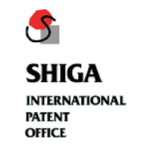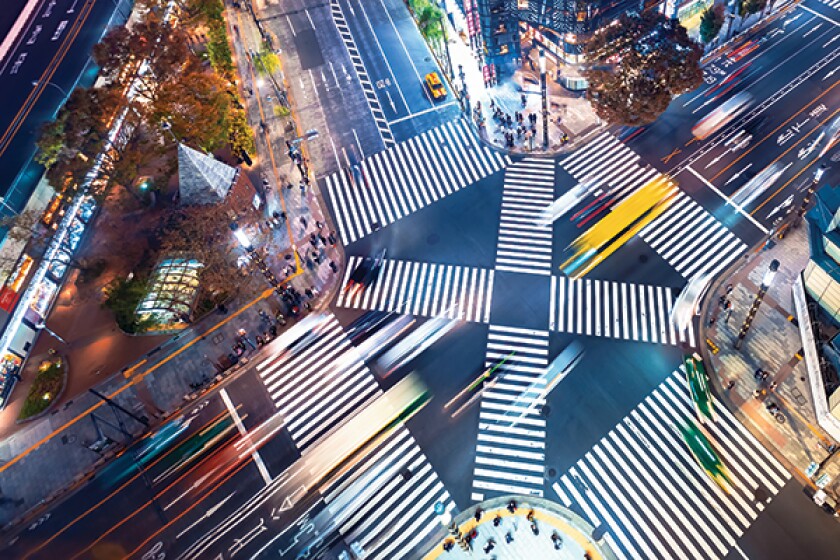These days, AI technology is applied in various technological fields. This article shows some trends patent applications for inventions using AI technology are following in Japan by reference to the following report by the JPO https://www.jpo.go.jp/system/patent/gaiyo/sesaku/ai/ai_shutsugan_chosa.html (Research on applications for AI-related inventions – available only in Japanese).
Trends in applications for AI-related inventions
The following graph (Graph 1) shows the number of AI-related applications which were filed between 2010 and 2018. Please note that the search strategy used to obtain the following statistics is slightly different from that used in the JPO's report.
Graph 1: The number of AI-related applications
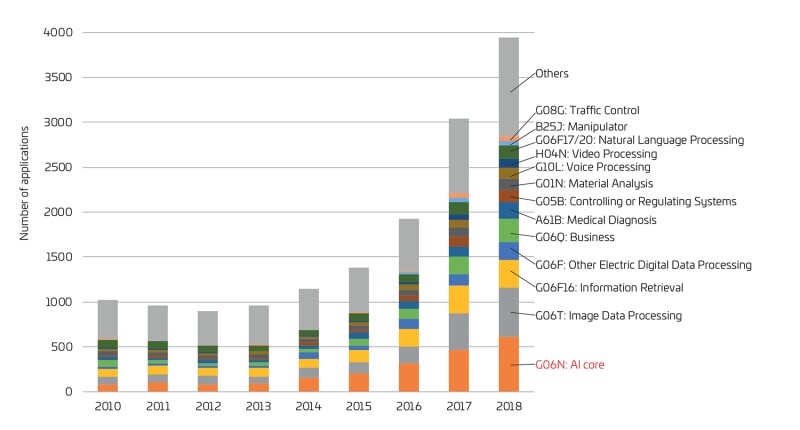
The number of applications for AI-related inventions has been increasing since 2014. Graph 1 also shows a breakdown of the number of applications by main international patent classifications (IPCs).
Graph 2 shows the change in ratio of the applications for the main IPCs between 2010 and 2018, working on the basis that the number of applications in 2010 is 100%.
Graph 2: The change in ratio of applications for each IPC
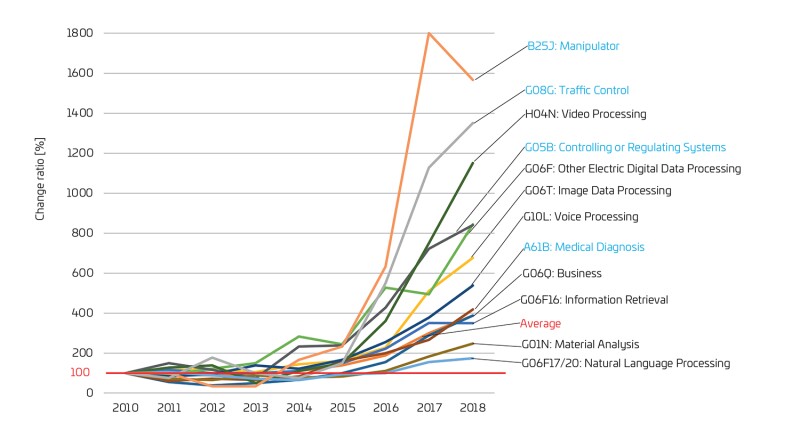
As Graph 2 shows, the number of applications in all technical fields has been increasing since 2016. The number of applications has been growing not only in image data processing (G06T), which is well known as one of the application fields of AI technology, but also in technical fields such as controlling or regulating systems (G05B), to which AI technology is increasingly applied. It is clear that AI technology is being applied to various technical fields.
In particular, control and robotics, including controlling or regulating systems (G05B), manipulators (B25J), traffic control (G08G) and medical diagnosis (A61B) show strong growth, among the technical fields to which AI-related technology is increasingly applied. This shows that AI technology has been diverted to these technical fields.
Based on these statistics, the following details the trends of AI-related inventions in each of the following technical fields: controlling or regulating systems, manipulators, traffic controls and medical diagnosis.
Application trends in technical fields to which AI-related technology is increasingly applied
Controlling or regulating systems (G05B)
AI technology is used to operate manufacturing machines and in factories. For example, AI technology is used to determine the conditions of manufacturing machines based on inputs from sensors in the manufacturing machines which control the motion of the manufacturing machines and any abnormal conditions.
The number of patent applications for AI-related inventions in the field of controlling or regulating systems and the ratio of applications in this arena are shown below.
As shown in Graph 3, both the number and ratio of AI-related inventions in this field have been increasing since 2013.
Graph 3: The number and ratio of patent applications for AI-related inventions in the field of controlling or regulating systems
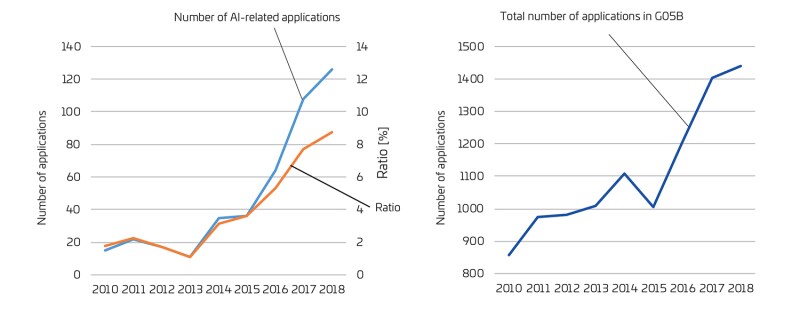
Breakdown of inventions by IPCs
The breakdown of inventions which were filed between 2016 and 2018, by their main IPCs, is shown below.
Graph 4 shows the number of patent applications related to adaptive control systems, programme-control systems and testing or monitoring of control systems. It is thought that this is because AI technology is suitable for selecting appropriate parameters or for determining the status of monitoring targets.
Graph 4: Breakdown of inventions filed between 2016 and 2018
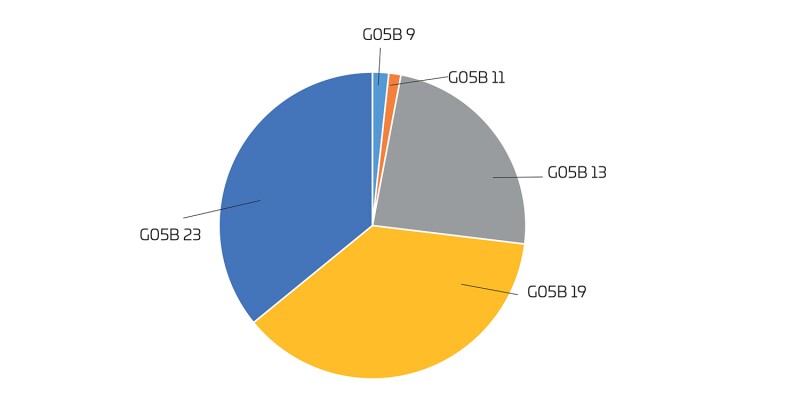
G05B 13: Adaptive control systems
G05B 19: Programme-control Systems
G05B 23: Testing or monitoring of control systems
Manipulators (B25J)
AI technology is being used for controlling robots. For example, AI technology is used to determine conditions of manufacturing machines based on inputs from sensors in the manufacturing machines in order to enable processing of objects with different shapes or to avoid interference with the workers around the robot.
The number of patent applications for AI-related inventions in the field of manipulators and the ratio of AI-related inventions in patent applications in the field of manipulators are shown below.
As shown in Graph 5, both the number and ratio of AI-related inventions in the field of manipulators have been increasing since 2013.
Graph 5: The number and ratio of patent applications of AI-related inventions in the field of manipulators
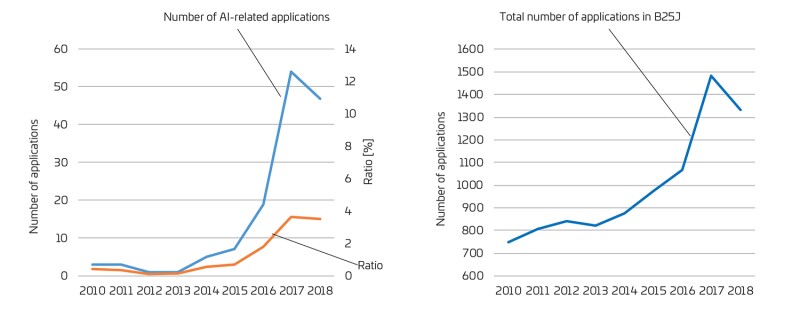
Breakdown of inventions by IPCs
The breakdown of inventions which were filed between 2016 and 2018 by their main IPCs is shown below.
As can be seen from Graph 6, the number of patent applications related to programme-controlled manipulators (B25J 9) and controls for manipulators (B25J 13) is high. This is thought to be because AI technology is suitable for controlling manufacturing machines into cooperating with an operator or for machining different objects. Other inventions such as one for ensuring a person's security by determining a positional relationship between a robot and a person also have a relatively high rate compared to others (B25J 19).
Graph 6: Breakdown of inventions filed between 2016 and 2018
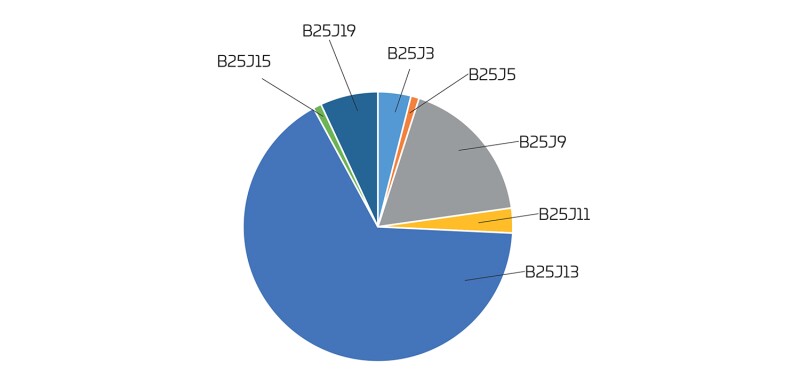
B25J 9: Programme-controlled manipulators
B25J 13: Controls for manipulators
B25J 19: Safety devices
Traffic controls (G08B)
AI technology is an essential technology for automatic operation in the traffic controls field. For example, AI technology is used to predict traffic conditions and AI technology, to which image processing technology is applied, is used to avoid collision with pedestrians or other automobiles.
The number of patent applications for AI-related inventions in the field of traffic controls and the ratio of AI-related inventions in patent applications in the field of traffic controls are shown below.
As shown in Graph 7, both the number and ratio of AI-related inventions in the field of traffic controls have been increasing since 2014.
Graph 7: The number and ratio of patent applications for AI-related inventions in the field of traffic controls
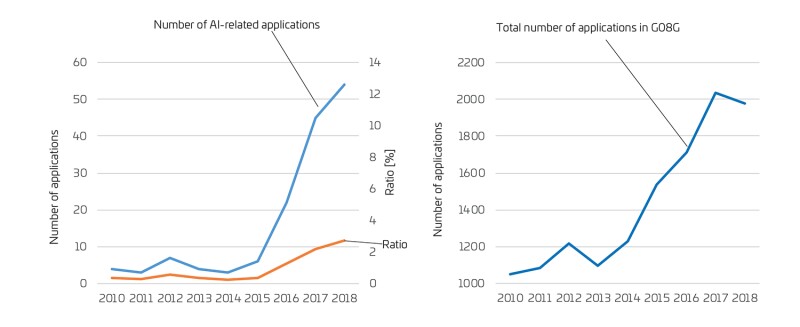
Breakdown of inventions by IPCs
The breakdown of inventions which were filed between 2016 and 2018 by their main IPCs is shown below.
It is clear from Graph 8 that the number of patent applications related to traffic control systems for road vehicles is high. This is assumed to be because automatic operation technology for automobiles has been developed recently. Although small in number, AI technology is just beginning to be applied to the fields of marine crafts and aircrafts. The breakdown of patent applications related to traffic control systems for road vehicles is shown below.
Graph 8: Breakdown of inventions filed between 2016 and 2018
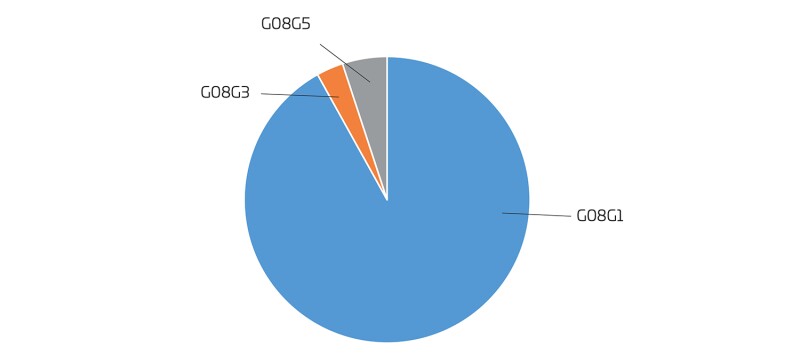
G08G 1: Traffic control systems for road vehicles
G08G 3: Traffic control systems for marine craft
G08G 5: Traffic control systems for aircraft
Graph 9: Breakdown of patent applications related to traffic control systems for road vehicles filed between 2016 and 2018
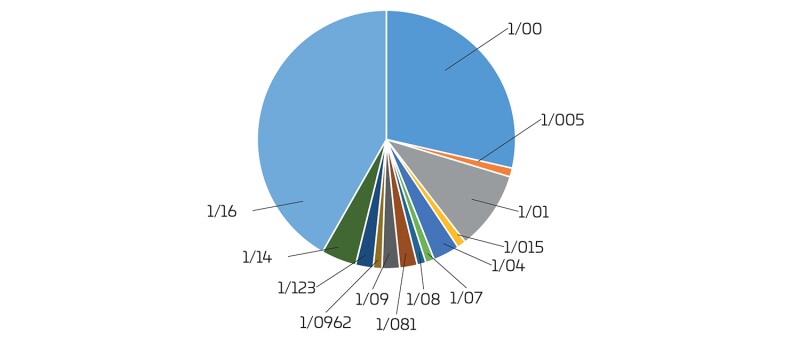
B25J 9: Programme-controlled manipulators
B25J 13: Controls for manipulators
B25J 19: Safety devices
As you can see from Graph 9, the number of patent applications related to general traffic control systems for road vehicles (G08G 1/00) and anti-collision systems (G08G 1/16) is high. Preventing collision of an automobile with pedestrians or other automobiles is the reason for popularisation of automatic operation technology.
Medical diagnosis (A61B)
AI technology is also used to process imaging data acquired by MRI and CT scans and to enable diagnosis in various situations. Furthermore, AI technology is also employed in the assessment of various bodily conditions based on biological information such as body temperature and heart rate.
The number of patent applications for AI-related inventions in the field of medical diagnosis and the ratio of AI-related inventions in patent applications in the field of medical diagnosis are shown below.
As Graph 10 shows, both the number and ratio of AI-related inventions in the field of medical diagnosis since 2014 has risen. In particular, the number and ratio of patent applications of AI-related inventions have been rising while the number of patent applications in the whole field of medical diagnosis has been decreasing since 2014.
Graph 10: The number and ratio of patent applications of AI-related inventions in the field of medical diagnosis
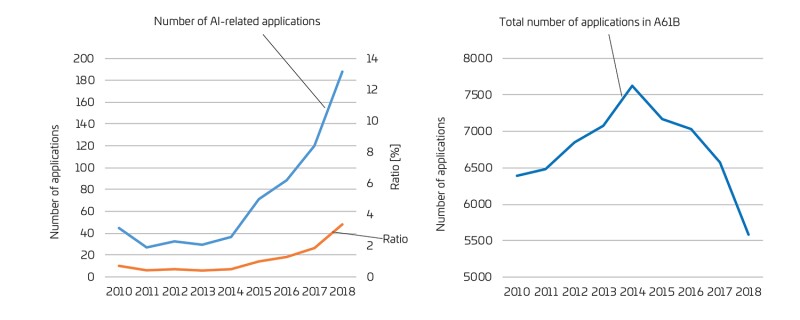
Breakdown of inventions by IPCs
The breakdown of inventions which were filed between 2016 and 2018 by their main IPCs is shown below.
As you can see from Graph 11, the number of patent applications related to diagnostic measurement (A61B 5) and radiation diagnostic apparatus (A61B 6) is large. This is because AI technology is suitable for the processing and diagnosis of measured data.
Graph 11: Breakdown of patent applications in the field of medical diagnosis filed between 2016 and 2018
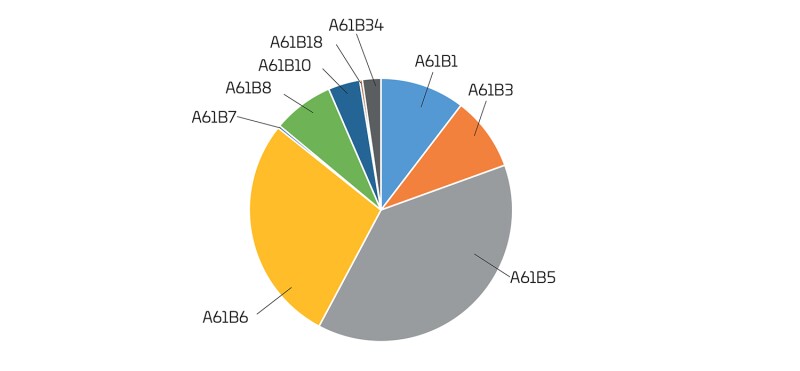
A61B 1: Endoscopes
A61B 3: Eye testing apparatus
A61B 5: Diagnostic measurement
A61B 6: Radiation diagnostic apparatus
A61B 8: Sonic wave diagnosis
Claim examples
The following are claim examples of AI-related inventions in some of the above fields.
1) JP6643211B1 (G05B: controlling or regulating systems)
[Claim 1]
An abnormality detection system for detecting an abnormality of a monitoring target system, the abnormality detection system comprising:
a memory; and
a processor;
the processor being configured to perform
a symbolising means which converts, based on a prescribed rule, a time-sequential event included in a log output by the monitoring target system into a symbolised event,
a learning means which learns, based on a normal-time log symbolised by the symbolising means, a symbolised event sequence, which appears in the same pattern, as a frequently-appearing pattern; and
an abnormality detecting means which detects an occurrence or a non-occurrence of an abnormality, based on whether or not the frequently-appearing pattern is occurring in a monitoring-time log symbolised by symbolising means, and
the abnormality detecting means being configured to
extract, based on a size of a symbolised event sequence constituting the frequently-appearing pattern, a symbolised event sequence to be a target of detection of whether or not the frequently-appearing pattern has occurred from the symbolised monitoring-time log, and
determine that an abnormality exists in cases where a partial pattern, which is a part of the frequently-appearing pattern, occurs in the extracted symbolised event sequence of the detection target and, at the same time, in cases where a rest pattern, which is a pattern that appears after the partial pattern of the frequently-appearing pattern, does not appear regardless of a probability of occurrence of the frequently-appearing pattern including the partial pattern when the partial pattern that occurs is equal to or larger than a prescribed threshold.
[Brief Summary]
The abnormality detection system learns the frequently-appearing patterns of the time-sequential events included in the log collected by the monitoring target system, and determines whether there is an abnormality in monitoring targets according to whether the frequently-appearing pattern occurs under the prescribed conditions.
2) JP6662746B1 (B25J: Manipulators)
[Claim 1]
A work assisting system comprising:
a sensor unit for detecting a position and an orientation of each of the body parts including a hand of a worker;
a supply unit for supplying a part or a tool to the worker; and
a cell controller for controlling the supply unit,
wherein the cell controller comprising:
a machine learning unit for constructing a learning model based on the detected position and orientation of each of the body parts and a label relating to a work status of the worker, and
a determining unit for determining the work status of the worker by using the constructed learning model,
wherein the supply unit comprises a sensor, selects the part or tool based on the determined work status and a work table in which the labelled work status is correlated to a motion of the supply unit, changes a position and orientation of the part or tool so that the coordinate system preset for each part or tool is coincident with the coordinate system that indicates the position and orientation representing each body part, and determines whether the tool or part has reached the position of the palm of the worker based on the detecting result of the sensor.
[Brief Summary]
The work assisting system learns relationship between workers' hands and orientations, and working conditions, and supplies a part or a tool to the worker at an optimal position and orientation based on a detected worker's hand and orientation.
3) JP6666202B1 (G08G: general traffic control systems for road vehicles)
[Claim 1]
An accident forecasting system comprising:
an accident forecast table creation processing unit which learns accident occurrence patterns based on a predetermined learning algorithm using past traffic data and past accident data for each of multiple routes where a traffic accident has occurred, and creates an accident forecast table representing a certain accident occurrence degree which shows probability of accident occurrence for each traffic situation;
an assignment table creation processing unit which, for a route where a traffic accident has occurred, assigns an accident forecast table created based on the data of the route, and for a route where no traffic accident has occurred, assigns the accident forecast table assigned to a route similar to one of the routes where a traffic accident has occurred, so as to create an assignment table;
a data acquisition processing unit which acquires current traffic data from a sensor measuring traffic conditions for a route to be forecast; and
an accident forecast processing unit which, for the forecast target route, forecasts the accident occurrence degree using the corresponding accident forecast table identified with reference to the assignment table, and the current traffic data.
[Brief Summary]
The accident forecasting system learns accident occurrence patterns based on past traffic data and past accident data to create an accident forecast table, for routes where accidents have occurred, and learns accident occurrence situations. In addition, the system assigns the accident forecast table for routes where any traffic accident has occurred, and the accident forecast table assigned to a route similar to one of the routes where any traffic accident has occurred, to routes where no traffic accident has occurred (for example, newly constructed routes), to create an assignment table. Then, the system forecasts a degree of accident occurrence using the accident forecast table and the current traffic data.
As mentioned above, the number of AI-related patent applications has been growing in recent years. It is expected that the number of applications in fields such as robot technology, automatic operation technology, and medical diagnosis, in which AI technology is increasingly used, will also further rise in the future.
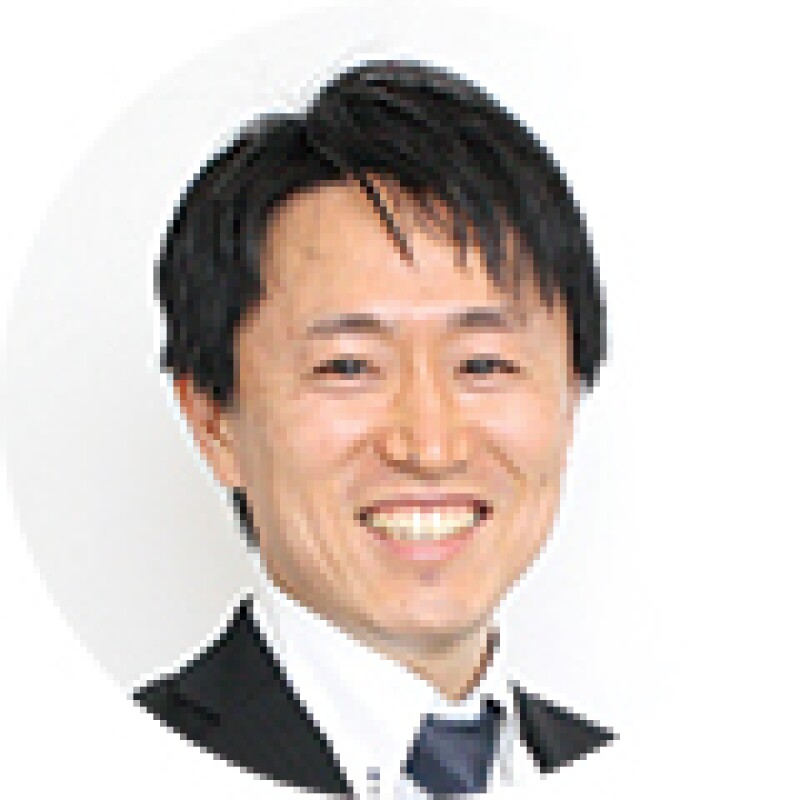
Shimpei Kuroda
Mr Kuroda specialises in industrial machinery. He has conducted research into semiconductor devices for optical communication, such as semiconductor lasers. Mr Kuroda regularly visits overseas clients, mainly in Europe and the US, to provide updated information on IP in Japan. He has experience in the research and development of optical transmitters and receivers for long-distance optical communication and signal waveforms with a low error rate.
